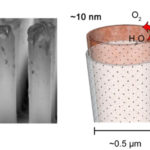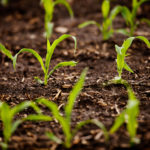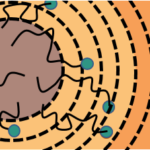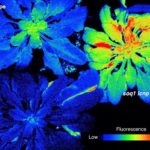“The key design principle of natural photosynthesis is the closing of the photosynthetic cycle on the shortest possible length scale under membrane separation of the incompatible water oxidation and proton reduction environments,” said Heinz Frei, a senior scientist in Biosciences’ Molecular Biophysics and Integrated Bioimaging (MBIB) Division. With collaborators Eran Edri, a former postdoctoral fellow in MBIB now at Ben-Gurion University, and Shaul Aloni in the Molecular Foundry Division, Frei developed a fabrication method to make a square-inch sized artificial photosystem, in the form of an inorganic core-shell nanotube array, that implements this design principle for the first time. The method was described in a paper published earlier this year in ACS Nano.
Scientists Engineer Plants to Thrive on 25% Less Water
Krishna Niyogi, a faculty scientist in Molecular Biophysics and Integrated Bioimaging (MBIB) and chair of the Department of Plant and Microbial Biology at UC Berkeley, identified a protein called Photosystem II Subunit S (PsbS) involved in regulating photosynthetic light harvesting and hypothesized that increasing the amount of this protein in a plant might make photosynthesis more efficient. In collaboration with researchers at University of Illinois, Urbana, he put this theory to the test. In field trials, the researchers found that increasing the expression of the gene for PsbS, which is found in all plants, improved crops’ water-use efficiency—the ratio of carbon dioxide entering the plant to water escaping—by 25 percent, without significantly sacrificing photosynthesis or yields. The extra PsbS protein tricks plants into partially closing their stomata, the microscopic pores in the leaf that allow water to escape. The study, published March 6 in Nature Communications, is part of an international research project, Realizing Increased Photosynthetic Efficiency (RIPE), supported in part by the Bill & Melinda Gates Foundation. Read more at UC Berkeley News.
Tracking Energy Flow in Light-harvesting Systems on Native Nanometer and Picosecond Scales
In the first trillionths of a second after sunlight hits a photosynthetic organism, the energy that is absorbed flows through a dense network of protein-bound chlorophyll molecules to a dedicated location where it is converted to electric charges. This is the first step in a series of events that ultimately drives the formation of sugar and starch to store energy in chemical bonds.
“This migration is the triggering event that leads to all of the oxygen that we breathe, all of the food that we have, and we really don’t understand why this part of photosynthesis works as well as it does. For every photon of light that’s absorbed, you can expect some biochemical action to occur. That efficiency is really remarkable,” says Naomi Ginsberg, a faculty scientist in the Molecular Biophysics and Integrated Bioimaging (MBIB) Division who has a secondary affiliation in Materials Sciences and is also a UC Berkeley associate professor of Chemistry and Physics.
Ginsberg and her colleagues devised a way to measure migration efficiency, and they describe the method in Nature Materials in November 2017.
Biosciences Researchers ID Plant ‘Sunscreen’ Protein
A protein that protects plants from damage caused by too much light energy has been found by a team of researchers led by Kris Niyogi, faculty scientist in the Molecular Biophysics and Integrated Bioimaging Division. Alizée Malnoë, a postdoctoral researcher in Niyogi’s group, is the lead author on the study published in the journal The Plant Cell. Plants with deficient levels of the lipocalin protein are less able to dissipate excess light energy. Scientists will explore how this energy dissipation process is turned on and off, and whether manipulation of light usage could lead to higher crop yields. Read more in the Berkeley Lab News Center.
UCB/UIUC Project to Improve Photosynthesis Receives Ongoing Support
A University of Illinois Urbana-Champaign research initiative on which Biosciences’ Krishna Niyogi has been a longtime collaborator received a $45 million, five-year reinvestment to continue efforts to re-engineer photosynthesis in staple crops order to sustainably increase yields worldwide. The new round of funding for Realizing Increased Photosynthetic Efficiency (RIPE) comes from the Bill & Melinda Gates Foundation, the Foundation for Food and Agriculture Research, and the U.K. Department for International Development. Niyogi, a faculty scientist in Molecular Biophysics and Integrative Bioimaging (MBIB) and chair of the Department of Plant and Microbial Biology at UC Berkeley, has been involved with RIPE since its inception. His research related to the project focuses on relaxing the protective mechanisms plants have developed to avoid damage to leaves from high-intensity light. Read more from UC Berkeley College of Natural Resources.
Was this page useful?








